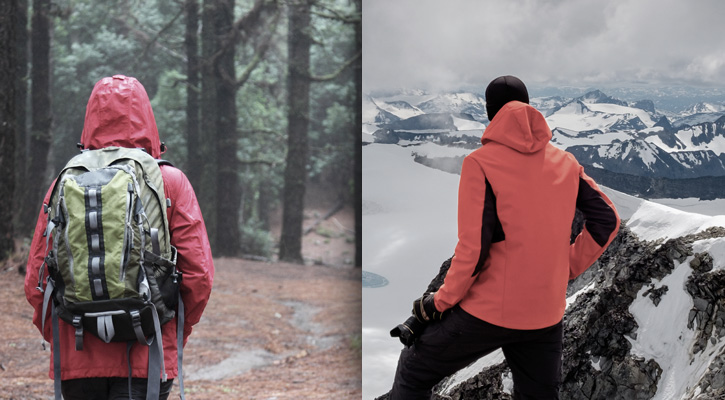
If you’re an avid hiker or backpacker, you know how important it is to have a reliable weatherproof or weather-resistant jacket, especially during the unpredictable spring and fall seasons.
A waterproof jacket is a must-have to protect you from the rain and cold temperatures. However, when it comes to choosing the right jacket, there are two common options: the traditional rain jacket and the newer hardshell jacket.
In this article, we’ll explore the main differences between these two types of jackets to help you make the right decision on which one is best suited for your needs.
Key Points:
- Rain jackets are designed to keep you dry and are typically made of hydrophobic fabrics like Polyester and Nylon.
- Hardshell jackets prioritize stiff waterproof materials over breathability and flexibility, also providing insulation.
- Rain jackets have a uniform appearance and fit tightly. Hardshell jackets offer more options and have a looser fit.
- Hardshells are more versatile in terms of weather resistance.
- Hardshells offer better insulation. Rain jackets provide poor heating and insulation.
- Hardshell jackets are more expensive.
- Rain jackets can be used as shells, but it is crucial to layer appropriately underneath.
- A hardshell jacket may not be necessary.
1. The Rain Jacket
To ensure a comprehensive understanding, let’s start with discussing the popular and widely known rain jacket.
Typically, a rain jacket is relatively thin and designed to keep you dry by preventing rain from penetrating through to your layers underneath.
While some rain jackets may offer light warmth depending on their lining, their primary function is to protect your head and torso from wet weather.

Manufacturers use various materials to create rain jackets, but the most effective ones are typically made of hydrophobic fabrics like Polyester and Nylon that repel water instead of absorbing it.
Unlike natural fabrics like cotton and wool, which are commonly found in outdoor clothing, these materials provide superior protection.
Although older rain jackets may not be breathable due to their thicker material, newer innovations like Gore-Tex membranes have made it possible to create lightweight and breathable rainwear that is also durable.
Gore-Tex is an excellent fabric technology that offers durability while being incredibly lightweight compared to other materials.
However, most rain jackets, especially lightweight ones, do not provide insulation, so you may need to layer other clothes underneath. Nevertheless, properly zipped and sealed rain jackets can help you trap heat from these other layers, making them quite comfortable to wear in colder weather.
Read also: Hiking vs Mountaineering: The Difference
2. The Hardshell Jacket
At first glance, hardshell jackets may look similar to rain jackets, causing confusion among consumers.
Hardshell jackets prioritize stiff waterproof materials over breathability and flexibility, making them good protectors against rain, wind, and other weather threats.
Hardshell jackets are rigid and sturdy compared to traditional rain jackets, providing an exceptional amount of insulation without relying on interior layers to keep you safe.
While some brands offer ventilation zippers to prevent overheating, this feature can make hardshell jackets less effective in rainy conditions, especially in warmer climates.

Don’t miss: 9 High-End, Expensive Hiking Brands for Clothing and Footwear
3. Comparison and Differences
Now it’s time to compare these two types of outerwear. When purchasing any jacket, four main categories should be considered, as they are the areas where these two types of rainwear can differ significantly.
Design and Fit
When it comes to style, traditional rain jackets tend to have a uniform appearance, fitting tightly on the body and prioritizing utility over comfort or fashion. However, given their effectiveness in protecting against the rain without taking up much space in a bag, their appearance is hard to fault.
In contrast, hardshell jackets offer more options, with some being as thin as rain jackets while others are more stylish. The lining of a hardshell jacket can influence its appearance, with some featuring softer fabrics for warmth and others serving as simple wind and water shields.
Regardless, hardshell jackets typically have a looser fit since their materials do not bend around the body as much as rain jackets.
Water Resistance and Weather Resistance
Despite their differences, both hardshell jackets and rain jackets can be equally waterproof as they are designed to repel water from their surfaces. Although they may be made of different materials, they are equally effective in achieving this goal.
When it comes to general weather resistance, hardshell jackets tend to be more versatile due to their rigid materials, which can provide better protection against wind.
As a result, looser hardshell jackets can be more comfortable in intense weather conditions. However, with a properly fitting rain jacket and appropriate layering, it is still possible for rain jackets to be sufficient in windy conditions.
Warmth
In general, hardshell jackets tend to offer better insulation due to their heavier materials. They do not require as much layering underneath as they are thicker than standard rain jackets.
Although hardshell jackets can vary in style and size, they provide a different approach to warmth compared to rain jackets.
In contrast, rain jackets tend to be more uniform and provide poor heating and insulation, requiring additional layers underneath to keep you comfortable.
While some hikers may see this as an advantage, allowing them to customize their clothing layers for the necessary level of resistance, caution should be exercised when taking a rain jacket into exceptionally cold and windy weather.
Price
Hardshell jackets tend to be more expensive due to their complex features, such as ventilation zippers, soft linings for warmth, and a greater emphasis on style and appearance.
While waterproof jackets can be found for under $100, high-end hardshell jackets can cost up to $350 or $400.
While solid rain jackets can also reach similar price points, it is easier to find budget options as they are simpler garments compared to hardshell jackets. Used rain jackets can often be found in stores as the materials do not typically degrade with use.
However, purchasing a new rain jacket is a safe investment as its quality will not degrade significantly over time.
Read next: 11 European Brands for Outdoor Enthusiasts: Our Top Picks
4. Is a Hardshell Jacket Really Necessary?
When it comes to the debate between hardshell versus rain jackets, both types of jackets are equally effective in their own ways. They cater to different needs and provide protection against different types of weather.
Choosing the appropriate jacket for your hiking conditions is crucial to ensure satisfaction, whether it be a hardshell jacket or a rain jacket.
Ultimately, a hardshell jacket may not be necessary, but it could be the ideal rainwear for you depending on your preferences.
5. Can I Use a Rain Jacket As a Shell?
In essence, rain jackets can be used as shells if they fit tightly. However, it is crucial to layer appropriately underneath, as they do not provide enough insulation to keep you warm.
Although it may require additional preparation, a hardshell jacket is not necessary to protect you from harsh weather.
6. Conclusions
This article should provide you with a better understanding of the type of jacket you should consider bringing on your rainy hikes.
Choosing the right jacket can significantly impact your hiking experience, making the difference between a bearable hike and a fantastic journey. These distinctions are crucial when searching for any type of jacket for challenging weather conditions.
